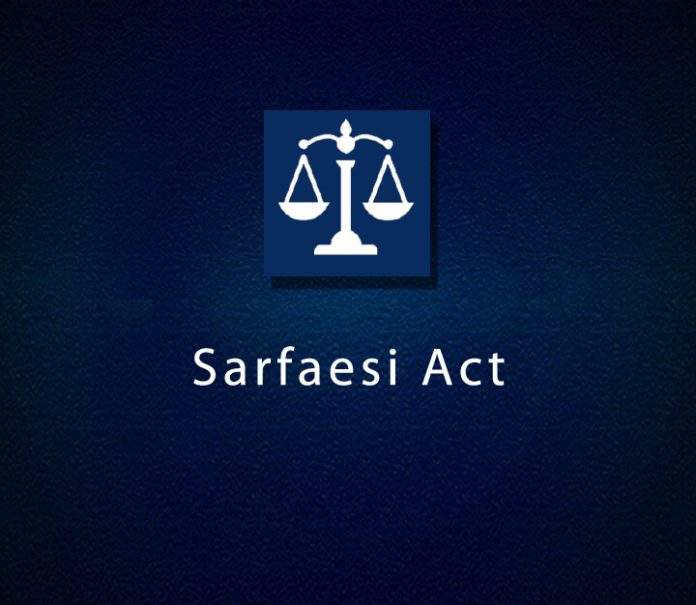This article is written by Arun Bapat, pursuing a Certificate Course in Insolvency and Bankruptcy Code from Lawsikho.com.
Table of Contents
Background of SARFAESI, 2002
The SARFAESI Act was passed on 17.12.2002. The very intention of this act is to enable the Banks and Financial Institutes to recover its money advanced quickly. The Act empowers the Banks and FI’s to auction the property mortgaged with them to recover such outstanding dues which is not paid for years despite repeated follow-ups’. Such unpaid money also is to be treated the non-performing assets (“NPA”) in the books of Banks and FI’s. The said property could be a residential or any commercial premises which has been mortgaged with the Bank or FI’s as and by way of security for the money advanced.
Prior to coming into force, the said SARFAESI Act the aggrieved parties i.e. Banks OR FI’s used to file a civil recovery case in the civil court and the matter used to continue for years together as the said civil suit was contested by both the parties. Considering this background, the Legislature felt to promulgate a specific legislation whereunder such NPA’s can be realised quickly so as to enable the Bank to lend the said recovered money back in the business. The recovery under the new Act saves banks and financial institutions time which otherwise would be a long drawn out process by filing a suit in a civil court.
One of the most important criteria under this SARFAESI Act is that the same is applicable only to the secured creditor resulting in the unsecured creditors being out of the purview of this Act.
Objectives of SARFAESI, 2002
- It is a legal framework for securitization activities.
- Security Interest can be enforced independent of court assistance.
- The Act promotes:
- Asset Management of Banks or Financial Institutions.
- Setting up of Asset Reconstruction & Asset securitization companies to effectively deal with the NPA’s.
- This Act gives full powers to the Banks and Financial Institution to take charge of the Hypothecated or mortgaged assets to recover NPA’s.
- The SARFAESI Act provides the following recovery channel for the recovery of NPAs, viz:
(i) Securitization;
(ii) Asset Reconstruction; and
(iii) Enforcement of Security without the intervention of the court.
What is asset reconstruction
The RBI regulation and the statutory provisions under the SARFAESI Act, 2002 covers the Asset Construction. It comprises as under:
- The simple meaning of “asset reconstruction” is nothing but converting bad or NPA’s to be converted into performing assets.
- It starts with purchase of bad asset by dedicated Asset Reconstruction Company which include hypothecated Asset, financing the bad assets converting into issuing Bonds, Securities and cash.
- By this method the Asset Reconstruction Company takes over or changes the management of the business of the borrower, the sale or lease of a part or whole of the business of the borrower; by rescheduling payment of debts payable by the borrower.
How the enforcement of security works
- As already mentioned above the SARFAESI Act empowers the Banks and Financial Institution to enforce its securities.
- The process commences by giving 60 days’ notice period to the Debtor to pay the due amount.
- On the failure the pay the said outstanding dues within the said statutory period gives power to the Banks and FI’s to enforce its SECURITY INTEREST by initiating the following steps:
- The Banks and Financial Institution has the right to take over the possession of the said secured property.
- The Banks or Financial Institution have the option to deal with such property by Sale or Lease or assign the right over the said security.
- Appointment of “Manager” to manage the said security.
- It can approach the debtors of the borrower company for realisation of borrower’s dues
Position in case more than one secured creditor
- One important caveat for the above process is that in the event of there exist more than 2 secured creditors then all decisions are taken only if 75% of them are in agreement to take action under the SARFAESI Act 2002.

Some thoughts on the Recovery of Debts due to Banks and Financial Institution Act, 1993 (“RDDBFI”)
Background
We are aware that the Banks and Financial Institutions in India (“FI”) are duly registered with the Apex Bank Regulatory Body I.e. Reserve Bank of India. The main object of the said banks and FI’s is to grant loan facility to the legal entities or to the individuals. It is universal fact that not all the loan borrowers repay the amount fully or even part payment resulting the recovery from them used pile up and as per the RBI guidelines the said loan is being declared as NON-PERFORMING ASSETS. (“NPA”)
Before the enactment of RDDBFI; the Banks or FI’s there was no other alternative but to approach the CIVIL CODE for its recoveries. Owing to the pending litigations in the civil courts it was difficult to recover the said NPA in a time bound manner.
The then Government appointed a committee headed by Mr. T. Tiwari who recommended that there has to be a quasi-judicial dedicated authority which can exclusively deal with and expeditiously dispose of all such recoveries of the NPA’s of the Banks and FI’s.
Accordingly, the Government promulgated the RDDBFI Act, 1993.
Authorities under the act:
- The Debt Recovery Tribunal (“DRT”) -with the limit of more than Rs.10 Lakhs due amount.
- The DRT has exclusive jurisdiction.
- The Debt Recovery Appellate Tribunal.
Type of recovery to be made
- The loan could be secured or unsecured or assigned and that the same could be by way of order under the court order or arbitration award or under any mortgage.
- The unique thing under this Act is that any loan by whatever background as detailed above can be triable before Debt Recovery Tribunal (“DRT”) unlike under the SARFAESI – only the SECURED LOAN to be tried before the DRT.
Insolvency and Bankruptcy Code, 2016 (“IBC”): applicability and objective
Background – prior to IBC
Before the IBC came into force the following were the acts/ methods through which the Governance of recovery of debt or reconstruction of the loans were undertaken through the following legal recourse:
- Securitization and Reconstruction of Financial Assets and Enforcement of Security Interest Act, 2002 (SAFAESI)
- Recovery of Debt due to Banks and Financial Institution Act, 1993
- Sick Industries (Special Provisions) Act, 1985
- RBI schemes such as corporate debt restructuring scheme or strategic debt restructuring
- Provincial Insolvency Act, 1920
- Presidency Town Insolvency Act, 1908
- Civil Procedure Code, 1908
- However, the aforesaid archive provisions were not serving the purpose for which they were designed. This was one of the factors which has direct nexus with “ease of doing business” in India the existing laws insolvency and bankruptcy were not capable of giving easy reliefs thereby such proceedings were also delayed.
- The old and archaic provisions to deal with the sickness arising out of the financial crunch have been replaced with this Code.
Object of code
The very purpose and object of this code is as under:
- The code is to consolidate and amend laws relating to reorganization & Individuals Resolution of Corporate Persons, Partnership firm & Individuals.
- Time bound manner.
- Speedy process of insolvency.
- To maximise the value of assets of such persons.
- It helps in promoting entrepreneurship.
- It balances the interests of all the stakeholders including alternation in the order of priority of payment of Government dues.
- Another objective of the Code is to establish the Insolvency and Bankruptcy Board of India.
Applicability of IBC Code, 2016
- The code applies to the whole of India.
- Part III of the code concerning Insolvency Resolution and Bankruptcy for individuals and partnership firms is not made operative as yet.
- The code is consolidated to cover every aspect of Insolvency and Bankruptcy.
- The Code provisions as on date are applicable to:
- Companies that are governed under special laws.
- Companies incorporated under the Companies Act.
- Limited Liability Partnership.
- The bodies which are notified by the Central Government.
- It also covers the personal guarantors of Corporate Debtor.
- Even though the Individuals and Partnership Firms are the part of the code; but they are not notified i.e not in operation as on date.
- This Code has an overriding effect over other laws.
- Though the IBC has an overriding effect, some provisions of the Companies Act, 2013 are still relevant. For example, issues concerning contributory, workmen dues for which no provision was made under the Code.
- Provisions of Companies Act, 2013 relating to winding up are applicable to the extent not contrary to the Code.
Let us discuss how SARFAESI differs from IBC in the following factors:
SARFAESI vs IBC
|
SARFAESI ACT |
IBC |
|
Under the SARFAESI Act, banks and other financial institutions, in the capacity of secured creditors are allowed to auction residential or commercial properties of borrowers to recover loans, without approaching the courts. |
The Insolvency and Bankruptcy Code, 2016 (“IBC”) was promulgated to provide a single unified framework to deal with bankruptcy and insolvency in respect of Corporates, Partnerships. LLP, individual’s partnership in a time bound manner. |
|
The securitization of assets (enforcement) or auction are the process under the SARFAESI Act. |
CIRP is the process under the IBC. |
|
In the capacity of secured creditors, the Banks and Financial Institutions are allowed to auction residential or commercial properties of borrowers to recover loans, without approaching the courts. |
Under the IBC secured creditors interests are compromised and does not have any prerogative. |
|
This Act deals with:
|
The Code consist of:
|
|
Under this Act,
|
|
In furtherance of the above let now discuss the three dominant legislations in relation to their very object of promulgations:
|
Acts |
Objects |
|
Securitization and Reconstruction of Financial Assets and Enforcement of Security Interest Act, 2002 |
Security enforcement. |
|
The Recovery of Debt Due to Banks and Financial Institution Act |
DEBT recovery by Banks and Finance Recovery. |
|
Companies Act, 2013 |
Liquidation and winding up of the company. |
|
Presidency Towns Insolvency Act and Provincial Insolvency Act |
For sickness and insolvency of Partnership firms and Individuals. |
Conclusion
- The sum and substance of the entire study reveals that the failure on the part of the above-mentioned statutes to achieve their respective OBJECTIVES gave birth to the present Insolvency & Bankruptcy Code, 2016.
- The statistical figures for the recovery of dues shows a considerable progress for the recovery of the dues from the Corporate Debtors to the Financial and Operational Creditors.
- Despite the above positive results of the IBC, 2016 the legislation is still at the nascent stage and naturally it does have a teething problem.
- Ever since the promulgation of the IBC 2016, there have been a number of amendments and modifications(s) to the existing Code which further strengthen the effectiveness of the Code.
Students of Lawsikho courses regularly produce writing assignments and work on practical exercises as a part of their coursework and develop themselves in real-life practical skill.
LawSikho has created a telegram group for exchanging legal knowledge, referrals and various opportunities. You can click on this link and join:
 Serato DJ Crack 2025Serato DJ PRO Crack
Serato DJ Crack 2025Serato DJ PRO Crack










 Allow notifications
Allow notifications



